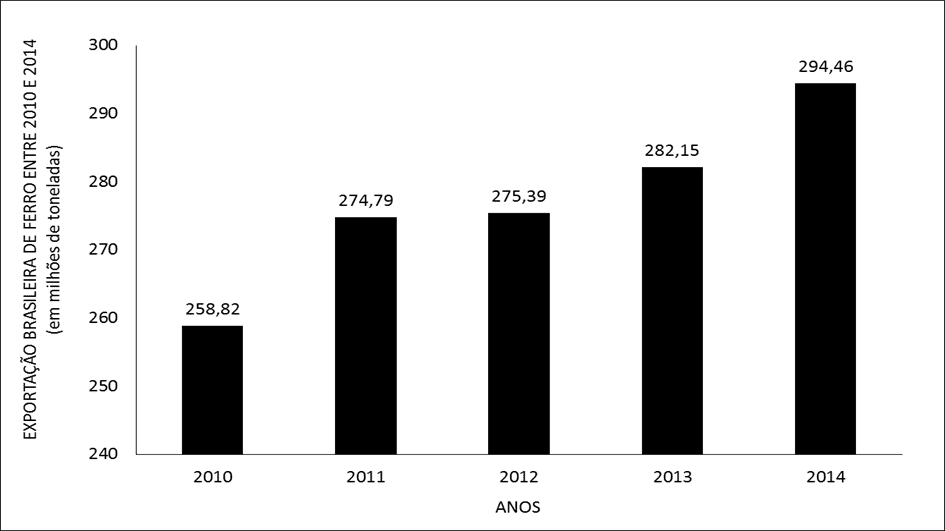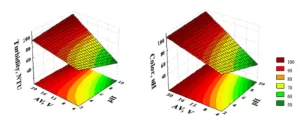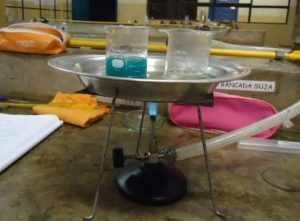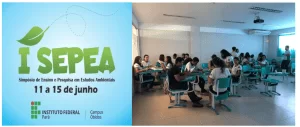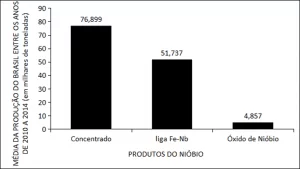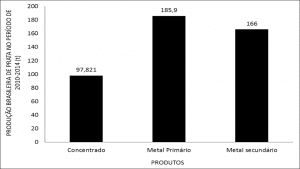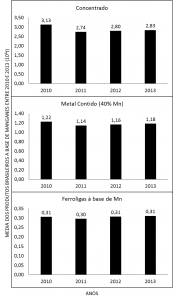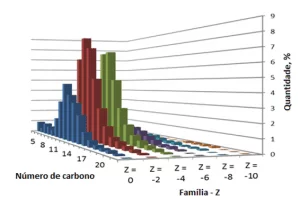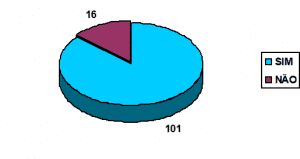ROCHA, Karina Dias [1], ARAÚJO, Franciolli da Silva Dantas [2], FECURY, Amanda Alves [3], OLIVEIRA, Euzébio [4], DENDASCK, Carla Viana [5], DIAS, Claudio Alberto Gellis de Mattos [6]
ROCHA, Karina Dias. Et al. National iron panorama between 2010 and 2014. Revista Científica Multidisciplinar Núcleo do Conhecimento. Year 03, Ed. 09, Vol. 08, pp. 55- 62 September 2018. ISSN:2448-0959, Acess Link: https://www.nucleodoconhecimento.com.br/quimica-en/iron, DOI: 10.32749/nucleodoconhecimento.com.br/quimica-en/iron
SUMMARY
Mining is the activity carried out that aims to remove a mineral good from the earth’s crust, representing about 5% of Brazil’s GDP in 2014. Iron is an easily oxidisable, dubious and magnetic chemical element. It is the most common, cheap and most important of metals. Hematite (Fe2 O3) is the main mineral with predominant iron content in its composition. In 2010, Brazil’s iron production accounted for about 15% of world production. The steel industry accounts for 99% of the world’s iron consumption. The sea route is the main means of transport of goods between Brazil and foreign trade. The research was carried out by accessing the DNPM website, the data collected were from 2010 to 2014. In this period Australia had the largest mineral reserve of iron and China the largest production in the world. In 2013 there was a fall in Brazilian iron production and its effective consumption. The national economy and world trade were the main factors for the instability of the Brazilian mineral sector between 2010 and 2014. The decrease in the price of iron in the world market caused the drop in iron production in Brazil in 2013, when iron consumption in Brazil was severely affected by the economic crisis that affected the country. China’s high investments in the mineral sector have boosted the country’s participation in world trade, becoming the world’s leading iron producer, between 2010 and 2014 China was the main buyer of iron produced in Brazil.
Keywords: Iron, mining, national trade.
INTRODUCTION
Iron is an easily oxidisable, dubious and magnetic chemical element. It is the most common, cheap and most important of metals (DNPM, 2017). ). The main sources of iron procurement are heatite, magnesite, siderite and pyrite. Hematite (Fe2 O3) is the main mineral with predominant iron content in its composition (MEDEIROS, 2010 ; DNPM, 2017a). Iron is widely used in the manufacture of car parts, gates, bridges, nails and screws in addition to being used in civil construction (MEDEIROS, 2010).
Mining is the activity carried out that aims to remove a mineral good from the earth’s crust (GANEM et al., 2016). In 2014 the sector represented 5% of the national GDP, raising about 42 billion dollars (BRASIL, 2015). Mineral is every substance formed by physical-chemical processes naturally in the earth’s crust (DNPM, 2017). Mineral reserve is the mineral occurrence identified and possible to be explored, which has economic connotation (CURI, 2014).
In 2010, Brazil’s iron production accounted for about 15% of world production, with about 372 million tons produced. The apparent consumption is the production of a well added to its import and subtracted from its export. Effective consumption consists of the apparent consumption subtracted from the final stock destocked from the initial stock (inventory variation), always calculated over a given period of time (HECK, 2007). The steel industry accounts for 99% of the world’s iron consumption (PEREIRA, 2012).
Export consists of the permanent or temporary departure of products from national manufacture, and can be paid or free of charge (BRASIL, 2015a). Brazil is the largest iron exporter in the world. In 2010, about 8000 mining companies operated in the country, 42% were concentrated in the Southeast Region, 24% in the South, 16% in the Northeast, 12% in the Midwest and 6% in the North (GONÇALVES and MENDONÇA, 2015).
In 2011, world trade using Free on Board (FOB) represented about 84% of exported products and 76% of imported volume (BRASIL, 2012). The FOB consists of an agreement between buyer and seller, the exporter is responsible only for the goods to the port (product inside the ship ready for transport), port indicated by the buyer (IPEA, 2010). The sea route is the main means of transport of goods between Brazil and foreign trade (BRASIL, 2012).
GOAL
Present the world reserve, price and world iron production between 2010 and 2014, as well as Brazilian exports and effective consumption in Brazil, aiming to make a national panorama of iron in this period.
METHOD
The research was carried out by accessing the DNPM (http://www.dnpm.gov.br/) website according to the following steps: on the main page, it was clicked on “publications”, then selected “statistical series and mineral economy”. On the next page, you clicked on “mineral summary”. Subsequently, “Brazilian Mineral Summary” was downloaded from 2011 to 2015. Then, in the downloaded summaries, data were collected from “World Reserve”, “World Production”, “Brazil Production”, “Export of Brazil”, “Apparent Consumption in Brazil”, “Effective Consumption in Brazil” and “Prices”. All data collected were from 2010 to 2014. The data was compiled within the Excel application, a component of the Microsoft Corporation Office suite. The bibliographic research was carried out in scientific articles, using computers from the computer laboratory of the Federal Institute of Education, Science and Technology of Amapá, Macapá Campus, located at: Rodovia BR 210 KM 3, s/n – Bairro Brasil Novo. ZIP Code: 68.909-398, Macapá, Amapá, Brazil.
RESULTS
Figure 1 shows the average of the world iron reserve (10^6 t) between 2010 and 2014. Australia had the highest average, followed by Russia and China. Ukraine had the lowest average, followed by India and Brazil.
Figure 1: Average world iron reserve between 2010 and 2014.
Figure 2 shows the average world iron production (10³ t) between 2010 and 2014. In the graph, it is perceived that China has the highest average, followed by Australia and Brazil. Ukraine had the lowest average, followed by Russia and India.
Figure 2: Average world iron production between 2010 and 2014.
Figure 3 shows the Brazilian iron production (t) between 2010 and 2014. There was a growth between 2010 and 2012, with a fall in 2013. In 2014, production growth resumed.
Figure 3: Brazilian iron production between 2010 and 2014.
Figure 4 shows brazilian iron exports (t) between 2010 and 2014. In the chart, there is an increase in exports in this period.
Figure 4: Brazilian iron exports between 2010 and 2014.
Figure 5 shows the effective consumption of iron (t) in Brazil between 2010 and 2014. The highest effective consumption was noted in 2011, followed by 2010 and 2012. The lowest effective consumption was in 2013, followed by 2014.
Figure 5: Effective iron consumption (t) in Brazil between 2010 and 2014.
Figure 6 shows the price of iron (US$-FOB/t) between 2010 and 2014. In the chart, we see the highest price in 2011, followed by 2013 and 2012. The lowest price was in 2014, followed by 2010. There is an oscillation between the years.
DISCUSSION
The banded iron formation (BIF) that occurred 2 billion years ago and mainly hit Australia, possibly the cause for the country to present the largest mineral reserve of iron in the period analyzed. Australia has the largest BIF reserve in the world, which has already owned about 300 trillion tonnes of iron and covered an area of approximately 150,000 km². BIF consists of sedimentary rocks that have minerals with high iron content, resulting from chemical processes between water with high iron content and water with a large amount of oxygen, causing heatite precipitation (WAM, 2013).
Probably the reason for China to present the highest iron production between 2010 and 2014 was the high investment that the country made in the mining sector, thus promoting the production of this sector and consequently increasing iron production (RÊGO et al., 2014).
The drop in iron production in Brazil in 2013 can be explained by the decrease in the price of the product in the world market, which made it impossible to achieve the desired profit and caused the unviability of production (ROCHA, 2016).
The cause for the growth of Brazilian iron exports between 2010 and 2014 was probably the economic growth of the main iron buyer produced in Brazil, China, a fact that increased the demand needed to feed its domestic market and consequently the volume of its import (SILVA, 2014).
The decrease in iron consumption in Brazil in 2013 can be explained by the economic crisis that affected the country in the period, consequently affecting industries that use iron through the impossibility of achieving the desired profit and caused the closure of several its head office, thus reducing the consumption of iron in the country (PAULA and PIRES, 2017).
The reason for the fall in the price of iron in 2014 was possibly the great supply of the product in the world market, surpassing the necessary demand. This can be explained by the excessive production in previous years, driven by high prices of the product in the world market, thus cheaping iron (BRASIL, 2014).
CONCLUSION
The national economy and world trade were the main factors for the instability of the Brazilian mineral sector between 2010 and 2014. The decrease in the price of iron in the world market caused the drop in iron production in Brazil in 2013, when iron consumption in Brazil was severely affected by the economic crisis that affected the country.
China’s high investments in the mineral sector have boosted the country’s participation in world trade, becoming the world’s leading iron producer, between 2010 and 2014 China was the main buyer of iron produced in Brazil.
REFERENCES
BRASIL. Panorama da Navegação Marítima e de Apoio: Superintendência de Navegação Marítima e de Apoio: 39 p. 2012.
______. Minério de Ferro: BNDES Setorial 39: 197-234 p. 2014.
______. Informações sobre a economia mineral brasileira: Instituto Brasileiro de Mineração: 25 p. 2015.
______. Exportação. 2015a. Disponível em: < http://idg.receita.fazenda.gov.br/orientacao/aduaneira/importacao-e-exportacao/despacho-aduaneiro-de-exportacao >. Acesso em: 13 de novembro, 2017.
CURI, A. Minas a céu aberto: planejamento de lavra. São Paulo: Oficina de Textos, 2014. 232 p.
DNPM. Ferro (Fe). 2017. Disponível em: < http://www.dnpm-pe.gov.br/Detalhes/Ferro.htm >. Acesso em: 14 de novembro, 2017.
______. Mineral. 2017a. Disponível em: < http://www.dnpm-pe.gov.br/Detalhes/Mineral.htm. >. Acesso em: 14 de novembro, 2017.
GANEM, R. S.; FILHO, A. F. F.; GANEM, R. S. I. Impactos Socioambientais de Mineração: Estudo de Caso em Pedreira. IV Congresso Baiano de Engenharia Sanitária e Ambiental. Cruz das Almas BA 2016.
GONÇALVES, R. J. F. A.; MENDONÇA, M. R. Expansão dos Grandes Empreendimentos de Mineração e Territórios em Disputa no Cerrado Goiano (Goiás/Brasil). Sociedade e Território, v. 27, p. 206-228, 2015.
HECK, N. C. Metalurgia Extrativa dos Metais Não-Ferrosos II. Porto Alegre RS, 2007. Disponível em: < https://www.academia.edu/29446651/ENG06632-Metalurgia_Extrativa_dos_Metais_N%C3%A3o-Ferrosos_II-A_Nestor_Cezar_Heck_-DEMET_UFRGS >. Acesso em: 20 de dezembro de 2017.
IPEA. O que é? FOB. 2010. Disponível em: < http://desafios.ipea.gov.br/index.php?option=com_content&view=article&id=2115:catid=28&Itemid=23 >. Acesso em: 07 de novembro, 2017.
MEDEIROS, M. A. Ferro. Química nova na Escola, v. 32, n. 3, p. 208-209, 2010
PAULA, L. F.; PIRES, M. Crise e perspectivas para a economia brasileira. Estudos Avançados, v. 31, n. 89, p. 125 – 144, 2017.
PEREIRA, S. A. C. O Mercado de Minério de Ferro. 2012. (Monografia). Universidade Federal de Minas Gerais, Belo Horizonte MG.
RÊGO, R. B. et al. Aplicação da Teoria das Opções Reais na Avaliação de um Projeto de Mineração. ENGEVISTA, v. 4, n. 16, 2014.
ROCHA, R. M. C. O Efeito China: Uma Análise para o mercado de Minério de Ferro entre 2002 e 2013. 2016. 54 p. (Monografia). Universidade Federal da Bahia, Salvador, BA.
SILVA, E. M. O Efeito China: Uma Análise para o mercado de Minério de Ferro entre 2002 e 2013. 2014. (Monografia). Pontifícia Univerdade Católica, Rio de Janeiro RJ.
WAM. Banded Iron Formation. 2013. Disponível em: < http://museum.wa.gov.au/research/collections/earth-and planetary-sciences/rock-collection/banded-iron-formation >. Acesso em: 20 de Dezembro, 2017.
[1] High school student. Technical Course in Mining. Federal Institute of Basic, Technical and Technological Education of Amapá (IFAP).
[2] Materials Technologist. Master in Materials Science and Engineering. Researcher Professor, Federal Institute of Basic, Technical and Technological Education of Amapá (IFAP)
[3] Biomedical. PhD in Tropical Diseases. Researcher Professor, Federal University of Amapá (UNIFAP).Biologist. Doctor of Tropical Diseases. Researcher Professor at the Federal University of Pará (UFPA).
[4] Biologist. Doctor of Tropical Diseases. Researcher Professor at the Federal University of Pará (UFPA).
[5] Theologian. PhD in Clinical Psychoanalysis. Researcher at the Center for Research and Advanced Studies, São Paulo, SP.
[6] Biologist. PhD in Theory and Behavior Research. Researcher Professor, Federal Institute of Basic, Technical and Technological Education of Amapá (IFAP)



